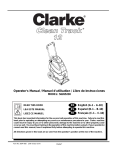Download Chapter 23: Series and Parallel Circuits
Transcript
Which Bulb Burns Brighter? One is a 60-watt bulb and the other a 100-watt bulb, and they are connected in an electric circuit. ➥ Look at the text on page 541 for the answer. CHAPTER 23 Series and Parallel Circuits our desk needs to be well lit. You have a 100-watt lightbulb and a 60-watt lightbulb available for your desk lamp. Which of the two lightbulbs would you choose? You know a watt is a unit of power, so you might expect that a 100-watt lightbulb would always produce more light than a 60-watt bulb. But would it? You’re shopping for a string of holiday lights for a party. You find a string of pumpkin lights with a tag that reads “If one goes out, the rest stay lit.” Why is this important? How are the lights connected to each other and the power source to make sure that the rest stay lit? Does the type of electric circuit that connects the bulb make a difference? Suppose the lightbulbs are in a circuit unlike the parallel circuit that normally connects lightbulbs in your home. For example, in the photo at the left, the bulbs are connected in series. Does that make a difference? Can you figure out why? To answer these questions, you need to know how a series circuit differs from a parallel circuit. In Chapter 22, you studied circuits that had one source of electric energy, for example, a battery and one device such as a motor or a lamp that converted the electric energy to another form. But circuits can be much more versatile than that. In this chapter, you’ll explore several ways in which devices may be connected in electric circuits. By the end of this chapter, you’ll have no trouble deciding which of the two bulbs at the left is brighter and why the rest of the bulbs stay lit. Y WHAT YOU’LL LEARN • • You will distinguish between parallel and series circuits and series-parallel combinations and solve problems dealing with them. You will explain the function of fuses, circuit breakers, and ground fault interrupters, and describe ammeters and voltmeters. WHY IT’S IMPORTANT • Electrical circuits are the basis of every electrical device, from electric lights to microwave ovens to computers. Understanding circuits helps you to use them, and to use them safely. PHYSICS To find out more about electrical circuits, visit the Glencoe Science Web site at science.glencoe.com 531 23.1 Simple Circuits I OBJ ECTIVES • Describe both a series connection and a parallel connection and state the important characteristics of each. • • Calculate current, voltage drops, and equivalent resistance for devices connected in series and in parallel. Describe a voltage divider and solve problems involving one. FIGURE 23–1 No matter what path the water of a river takes down a mountain, the amount of water and the drop in elevation are the same. 532 Series and Parallel Circuits f you have ever had the chance to explore rivers in the mountains, such as the river shown below in Figure 23–1, the following description will be familiar. From their sources high in the mountains, rivers make their way to the plains below. No matter what path they take, the change in elevation, from the mountaintop to the plain, is the same. Some rivers flow in a single stream, tumbling through a series of rapids and over waterfalls. Other rivers split into two or more streams as they flow over a waterfall or through the rapids. Part of the river follows one path; other parts find different routes. But no matter how many paths the water takes, the total amount of water flowing down the mountain is the same, and the vertical drop from mountaintop to plain is the same distance. Mountain rivers can serve as a model for electric circuits. The distance the water drops is similar to potential difference. The amount of water flowing through the river each second is similar to current. Narrow rapids are like a large resistance. But what is similar to a battery or generator? Just as in an electrical circuit, an energy source is needed to raise water to the top of the mountain. As you learned in Earth science, the source of energy is the sun. Solar energy evaporates water from lakes and seas and forms clouds that release rain or snow to fall on the tops of mountains. Think about the mountain river model as you read about the current in electrical circuits. Series Circuits Pat, Chris, and Ali were connecting two identical lamps to a battery as illustrated in Figure 23–2. Before making the final connection to the battery, their teacher asked them to predict the brightness of the two lamps. They knew that the brightness of a lamp depends on the current flowing through it. Pat said that only the lamp closer to the + terminal of the battery would light because all the current would be converted into light. Chris said that the second lamp would light, but it would be dimmer than the other one because some electrical energy would be changed into thermal and light energy. Consequently, there would be less electrical energy left for the second lamp. Ali said that both lamps would be equally bright because current is a flow of charge, and because the charge leaving the first lamp had nowhere else to go in the circuit except through the second lamp, the current would be the same in the two lamps. Who do you think is right? If you consider the mountain river model for this circuit, you’ll see that Ali is correct. Charge has only one path to follow. Recall from Chapter 20 that charge cannot be created or destroyed, so the same amount of charge must leave a circuit as enters the circuit. This means that the current is the same everywhere in the circuit. If you connect three ammeters into a circuit as shown in Figure 23–3, they all have the same value. A circuit such as this, in which all current travels through each device, is called a series circuit. But how could you answer Chris? If the current is the same, what changes in the lamp to produce the thermal and light energy? Recall that power, the rate at which electrical energy is converted, is represented by P IV. Thus, if there is a potential difference or voltage drop across the lamp, then electrical energy is being converted into another form. The resistance of the lamp is defined as R V/I. Thus, the potential difference, also called the voltage drop, is V IR. + – FIGURE 23–2 What is your prediction about the brightness of the two lightbulbs? What is the current in the series circuit? From the river model, you know that the sum of the drops in height at each rapid is equal to the total drop from the top of the mountain to sea level. In the electrical circuit, the increase in voltage provided by the generator or other energy source, Vsource, is equal to the sum of voltage drops across the lamps A and B. Vsource VA VB Because the current, I, through the lamps is the same, VA IRA and VB IRB. Therefore, Vsource IRA IRB or Vsource I(RA RB). The current through the circuit is represented by the following. Vsource I RA RB This equation applies to any number of resistances in series, not just two. The same current would exist with a single resistor, R, that has a RA + – Vsource RB FIGURE 23–3 The ammeters show that in a series circuit the current is the same everywhere. 23.1 Simple Circuits 533 F.Y.I. Henry Cavendish used the direct approach to measure the strength of an electric current. Lacking the appropriate instruments, he instead shocked himself with the current and then estimated the pain. resistance equal to the sum of the resistances of the two lamps. Such a resistance is called the equivalent resistance of the circuit. For resistors in series, the equivalent resistance is the sum of all the individual resistances. Equivalent Resistance for Resistors in Series R RA RB . . . Notice that the equivalent resistance is larger than any single resistance. Therefore, if the battery voltage doesn’t change, adding more devices in series always decreases the current. To find the current, I, through a series circuit, first calculate the equivalent resistance, R, and then use the following equation to calculate I. Current Vsource I R Practice Problems Pocket Lab Series Resistance Hook up a power supply, a resistor, and an ammeter in a series circuit. Predict what will happen to the current in the circuit when a second, identical resistor is added in series to the circuit. Predict the new currents when the circuit contains three and four resistors in series. Explain your prediction. Try it. Analyze and Conclude Make a data table to show your results. Briefly explain your results. (Hint: Include the idea of resistance.) 534 Series and Parallel Circuits 1. Three 20- resistors are connected in series across a 120-V generator. What is the equivalent resistance of the circuit? What is the current in the circuit? 2. A 10- resistor, a 15- resistor, and a 5- resistor are connected in series across a 90-V battery. What is the equivalent resistance of the circuit? What is the current in the circuit? 3. Consider a 9-V battery in a circuit with three resistors connected in series. a. If the resistance of one of the resistors increases, how will the series resistance change? b. What will happen to the current? c. Will there be any change in the battery voltage? 4. A string of holiday lights has ten bulbs with equal resistances connected in series. When the string of lights is connected to a 120-V outlet, the current through the bulbs is 0.06 A. a. What is the equivalent resistance of the circuit? b. What is the resistance of each bulb? 5. Calculate the voltage drops across the three resistors in problem 2, and check to see that their sum equals the voltage of the battery. Voltage drops in a series circuit In any circuit, the net change in potential as current moves through it must be zero. This is because the electrical energy source in the circuit, the battery or generator, raises the potential. As current passes through the resistors, the potential drops an amount equal to the increase, and, therefore, the net change is zero. The potential drop across each resistor in a series circuit can be calculated by rearranging the equation that defines resistance, R V/I, to solve for V, V IR. First, find the equivalent resistance, R, in the circuit by calculating the sum of all the individual resistances. Then, to find the current, which is the same everywhere in the circuit, use the equivalent resistance and the equation I V/R, where V is the potential drop. Having determined the current in the circuit, multiply I by the resistance of the individual resistor to find the potential drop across that resistor. An important application of series resistors is the voltage divider. A voltage divider is a series circuit used to produce a voltage source of desired magnitude from a higher-voltage battery. Suppose you have a 9V battery but need a 5-V potential source. A voltage divider can supply this voltage. Consider the circuit shown in Figure 23–4. Two resistors, RA and RB, are connected in series across a battery of magnitude V. The equivalent resistance of the circuit is R RA RB. The current, I, is represented by the following equation. V V I R RA RB RA + I V – RB VB FIGURE 23–4 The values of RA and RB are chosen such that the voltage drop across RB is the desired voltage. The desired voltage, 5 V, is the voltage drop, VB, across resistor RB. VB IRB. I is replaced by the preceding equation. V VB IRB RB RA RB The Inverse Key VRB VB RA RB Voltage dividers are often used with sensors such as photoresistors. The resistance of a photoresistor depends upon the amount of light that strikes it. Photoresistors are made of semiconductors such as silicon, selenium, and cadmium sulfide. A typical photoresistor can have a resistance of 400 when light strikes it, but 400 000 when in the dark. The output voltage of a voltage divider that uses a photoresistor depends upon the amount of light striking the photoresistor sensor. This circuit can be used as a light meter, such as the one in Figure 23–5. In this device, an electronic circuit detects the potential difference and converts it to a measurement of illuminance that can be read on the digital display. Amplified Voltmeter Because multiplication is the inverse of division, you can use the inverse key, 1/x, to perform calculation without having to reenter numbers. (9 V)(500 ) 400 500 Keys Display 400 1/x 9 500 900 1.11 . . . 03 500 5 Answer 5 V Sensitivity adjustment (potentiometer) Dry cells Light Photoresister sensor FIGURE 23–5 The output voltage of this voltage divider depends upon the amount of light striking the photoresistor sensor. This is the basis for the light meter shown at left. 23.1 Simple Circuits 535 Example Problem Voltage Drops in a Series Circuit Two resistors, 47.0- and 82.0-, are connected in series across a 45.0-V battery. a. What is the current in the circuit? b. What is the voltage drop across each resistor? c. The 47.0- resistor is replaced by a 39.0- resistor. Will the current increase, decrease, or remain the same? d. What will happen to the voltage drop across the 82.0- resistor? Sketch the Problem • Draw a schematic of the circuit. • Include an ammeter and voltmeters. A Calculate Your Answer Known: Unknown: Vsource 45.0 V I? RA 47.0 VA ? RB 82.0 VB ? + RA V VA – RB VB effects of changing RA Strategy: Calculations: a. To determine the current, first find the equivalent resistance. R RA RB Vsource Vsource I R RA RB 45.0 V I 0.349 47.0 82.0 b. Use V IR for each resistor. VA IRA (0.349)(47.0 ) 16.4 V VB IRB (0.349)(82.0 ) 28.6 V c. Calculate current again using RA as 39.0 . Vsource 45.0 V 0.372 I RA RB 39.0 82.0 The current will increase. d. Determine new voltage drop. VB IRB (0.372)(82.0 ) 30.5 V The voltage will increase. Check Your Answer • Are the units correct? Current, A V/, voltage, V A. • Is the magnitude realistic? Numerically, R > V, so I < 1. R decreases so I increases. VB changes because it depends on I. 536 Series and Parallel Circuits Example Problem Voltage Divider A 9.0-V battery and two resistors, 400 and 500 , are connected as a voltage divider. What is the voltage across the 500- resistor? I Sketch the Problem + • Draw the battery and resistors in a series circuit. – Calculate Your Answer Known: Strategy: Vsource 9.0 V Write the expression for the current through the circuit. RA 400 RB VB V Calculations: Vsource I R R RA RB RB 500 Determine equivalent resistance, R. Unknown: Use voltage drop equation to determine VB. VB ? RA (Vsource)(RB) VB IRB RA RB (9.0 V)(500 ) VB 5 V 400 500 Check Your Answer • Are the units correct? V V /. • Is the magnitude realistic? The voltage drop is less than the battery voltage. Because 500 is more than half of the equivalent resistance, the voltage drop is more than half the battery voltage. Practice Problems 6. A 20.0- resistor and a 30.0- resistor are connected in series and placed across a 120-V potential difference. a. What is the equivalent resistance of the circuit? b. What is the current in the circuit? c. What is the voltage drop across each resistor? d. What is the voltage drop across the two resistors together? 7. Three resistors of 3.0 k, 5.0 k, and 4.0 k are connected in series across a 12-V battery. a. What is the equivalent resistance? b. What is the current through the resistors? c. What is the voltage drop across each resistor? d. Find the total voltage drop across the three resistors. F.Y.I. The largest voltages in your home are in your television set, where 15 000 V to 20 000 V are common. The largest currents are likely to be the 40 A in an electric range. Continued on next page 23.1 Simple Circuits 537 RC RB RA Generator FIGURE 23–6 The parallel paths for current in this diagram are analogous to the paths that a river may take down the mountain. 8. A photoresistor is used in a voltage divider as RB. V 9.0 V and RA 500 . a. What is the output voltage, VB, across RB, when a bright light strikes the photoresistor and RB 475 ? b. When the light is dim, RB 4.0 k. What is VB? c. When the photoresistor is in total darkness, RB 0.40 M (0.40 106 ). What is VB? 9. A student makes a voltage divider from a 45-V battery, a 475-k (475 103 ) resistor, and a 235-k resistor. The output is measured across the smaller resistor. What is the voltage? Parallel Circuits Look at the circuit shown in Figure 23–6. How many current paths are there? The current from the generator can go through any of the three resistors. A circuit in which there are several current paths is called a parallel circuit. The three resistors are connected in parallel; both ends of the three paths are connected together. In the mountain river model for circuits, such a circuit is illustrated by three paths for the water over a waterfall. Some paths may have a large flow of water, others a small flow. The sum of the flows, however, is equal to the total flow of water over the falls. In addition, it doesn’t matter which channel the water flows through because the drop in height is the same. Similarly, in a parallel electrical circuit, the total current is the sum of the currents through each path, and the potential difference across each path is the same. What is the current through each resistor? It depends upon the individual resistance. For example, in Figure 23–7, the potential difference across each resistor is 120 V. The current through a resistor is given by I V/R, so you can calculate the current through the 24- resistor as I (120V)/(24 ) 5 A. Calculate the currents through the other two resistors. The total current through the generator is the sum of the currents through the three paths, in this case, 38 A. What would happen if the 6- resistor were removed from the circuit? Would the current through the 24- resistor change? That current depends only upon the potential difference across it and its resistance, and neither has changed, so the current is unchanged. The same is true 38 A A A 5A A 13 A A 20 A 120 V FIGURE 23–7 In a parallel circuit, the reciprocal of the total resistance is equal to the sum of the reciprocals of the individual resistances. 538 Series and Parallel Circuits 24 V 120 V 9 V 120 V 6 120 V V for the current through the 9- resistor. The branches of a parallel circuit are independent of each other. The total current through the generator, however, would change, and the sum of the currents in the branches would then be 18 A. How can you find the equivalent resistance of a parallel circuit? In Figure 23–7, the total current through the generator is 38 A. A single resistor that would have a 38-A current when 120 V were placed across it would be represented by the following equation. V 120 V R 3.2 I 38 A Notice that this resistance is smaller than that of any of the three resistors in parallel. Placing two or more resistors in parallel always decreases the equivalent resistance of a circuit. The resistance decreases because each new resistor provides an additional path for current, increasing the total current while the potential difference remains unchanged. To calculate the equivalent resistance of a parallel circuit, first note that the total current is the sum of the currents through the branches. If IA, IB, and IC are the currents through the branches and I is the total current, then I IA IB IC. The potential difference across each resistor is the same, so the current through each resistor, for example, RA, can be found from IA V/RA. Therefore, this becomes the equation for the sum of the currents: V V V V R RA RB RC Pocket Lab Parallel Resistance Hook up a power supply, a resistor, and an ammeter in a series circuit. Predict what will happen to the current in the circuit when a second, identical resistor is added in parallel to the first. Predict the new currents when the circuit contains three and four resistors in parallel. Explain your prediction. Try it. Analyze and Conclude Make a data table to show your results. Briefly explain your results. (Hint: Include the idea of resistance.) Dividing both sides of the equation by V provides an equation for the equivalent resistance of the three parallel resistors. Equivalent Resistance for Resistors in Parallel 1 1 1 1 R RA RB RC This equation can be used for any number of resistors in parallel. Example Problem Equivalent Resistance and Current in a Parallel Circuit Three resistors, 60.0 , 30.0 , and 20.0 , are connected in parallel across a 90.0-V battery. a. Find the current through each branch of the circuit. b. Find the equivalent resistance of the circuit. c. Find the current through the battery. Sketch the Problem • Draw a schematic of the circuit. • Include ammeters to show the paths of the currents. A A IC IB IA A A 90.0 V 60.0 30.0 20.0 Continued on next page 23.1 Simple Circuits 539 Calculate Your Answer Known: Unknown: RA 60.0 RC 20.0 IA ? IC ? R ? RB 30.0 V 90.0 V IB ? I? Strategy: a. The voltage across each resistor is the V same, so use I for each branch. R Calculations: V 90.0 V IA 1.50 A RA 60.0 V 90.0 V IB 3.00 A RB 30.0 V 90.0 V IC 4.50 A RC 20.0 b. Use the equivalent resistance equation for parallel circuits. 1 1 1 1 R RA RB RC 1 1 1 1 0.100 1 R 60.0 30.0 20.0 R 10.0 V c. Use I to find the total current. R V 90.0 V I 9.00 A R 10.0 Check Your Answer • Are your units correct? Currents are in amps, resistances are in ohms. • Do the signs make sense? All are positive, as they should be. • Is the magnitude realistic? IA IB IC I Practice Problems 10. Three 15- resistors are connected in parallel and placed across a 30-V battery. a. What is the equivalent resistance of the parallel circuit? b. What is the current through the entire circuit? c. What is the current through each branch of the circuit? 11. A 120.0- resistor, a 60.0- resistor, and a 40.0- resistor are connected in parallel and placed across a 12.0-V battery. a. What is the equivalent resistance of the parallel circuit? b. What is the current through the entire circuit? c. What is the current through each branch of the circuit? 12. Suppose one of the 15.0- resistors in problem 10 is replaced by a 10.0- resistor. a. Does the equivalent resistance change? If so, how? 540 Series and Parallel Circuits b. Does the amount of current through the entire circuit change? In what way? c. Does the amount of current through the other 15.0- resistors change? In what way? Now that you have learned about both parallel and series circuits, you can analyze the brightness of the 60-W and 100-W lamps shown in the photo at the beginning of this chapter. The brightness of a lightbulb is proportional to the power dissipated by it. Used in the normal way, each bulb would be connected across 120 V. Based on what you learned in Chapter 22, the resistance of the 60-W bulb is higher than that of the 100-W bulb. But when the bulbs are connected in series, the current through the two bulbs is the same, so P I2R. The higher-resistance lamp, the 60-W lamp, now dissipates more power and glows brighter than the 100-W lamp. 23.1 Which Bulb Burns Brighter? ➥ Answers question from page 530. Section Review 1. Are car headlights connected in series or parallel? Draw on your experience. 2. Lamp dimmers often contain variable resistors. a. Would a dimmer be hooked in series or in parallel with the lamp to be controlled? Why? b. Should the resistance of the dimmer be increased or decreased to dim the lamp? 3. A switch is connected in series with a 75-W bulb to a source of 120 V. resistors. Suppose a wire is added to connect points A and B. Answer the following questions, explaining your reasoning. a. What is the current through the wire? b. What happens to the current through each resistor? c. What happens to the current drawn from the battery? d. What happens to the potential difference across each resistor? a. What is the potential difference across the switch when it is closed or on? R b. What is the potential difference across the switch when it is open, or off? Explain. 4. A Figure 23–8 has four identical B R Critical Thinking The circuit in R R FIGURE 23–8 23.1 Simple Circuits 541 23.2 Applications of Circuits Y OBJ ECTIVES • Explain how fuses, circuit breakers, and ground-fault interrupters protect household wiring. • Analyze combined seriesparallel circuits and calculate the equivalent resistance of such circuits. • State the important characteristics of voltmeters and ammeters, and explain how each is used in circuits. ou have already learned some of the elements of household wiring circuits. It’s important to understand the requirements and limitations of these systems. Above all, it is important to be aware of the safety measures that must be practiced to prevent accidents. Safety Devices In an electric circuit, fuses and circuit breakers are switches that act as safety devices. They prevent circuit overloads that can occur when too many appliances are turned on at the same time or a short circuit occurs in one appliance. When appliances are connected in parallel, each additional appliance placed in operation reduces the equivalent resistance in the circuit and causes more current through the wires. The additional current may produce enough thermal energy (P I2R) to melt insulation on the wires and cause a short circuit in the wires or even a fire. A fuse is a short piece of metal that melts if too large a current passes through it. The thickness of the metal to be used is determined by the amount of current that can be safely handled by the circuit. Should there be a larger current through the circuit, the fuse will melt and break the circuit. A circuit breaker, shown in Figure 23–9, is an automatic switch that opens when the current reaches some set value. If current greater than the set value flows in the circuit, the circuit is overloaded. The circuit breaker will open and thereby stop all current. A ground-fault interrupter is often required by law in electrical outlets in bathrooms and kitchens. Current follows a single path from the power source into the electrical outlet and back to the source. Sometimes, when an appliance such as a hair dryer is used, the appliance or user might touch a cold water pipe or a sink full of water and in this way create another current path through the user. If a current as small as 5 mA should follow this path through a person, it could result in serious injury. The ground-fault interrupter contains an electronic circuit On-off reset switch handle Switch contacts FIGURE 23–9 When too much current flows through the bimetallic strip, it will bend down and release the latch. The handle moves to the off position causing the switch to open, and that breaks the circuit. 542 Series and Parallel Circuits Current out to loads Bimetallic strip Latch Circuit Breaker Current in from central switch 15 A fuse 120 V that detects small differences in current caused by an extra current path and opens the circuit, thereby preventing dangerous shocks. Electric wiring in homes uses parallel circuits, such as the one diagrammed in Figure 23–10, so that the current in any one circuit does not depend upon the current in the other circuits. The current in a device that dissipates power, P, when connected to a voltage source, V, is represented by I P/V. Suppose, that in the schematic diagram shown in Figure 23–10, a 240-W television is plugged into a 120-V outlet. The current that flows is represented by I (240 W)/(120 V) 2 A. Then, a 720-W curling iron is plugged in. The current through the curling iron is I (720 W)/(120 V) 6 A. Finally, a 1440-W hair dryer is plugged in. The current through the hair dryer is I (1440 W)/(120 V) 12 A. The current through these three appliances can be found by considering them as resistors in a parallel circuit in which the current through each appliance is independent of the others. The value of the resistance is found by calculating the current the appliance draws and then using the equation R V/I. The equivalent resistance of the three appliances is 1 1 1 1 1 R 10 20 60 6 R 6 . The 15-A fuse is connected in series with the power source so the entire current passes through it. The current through the fuse is V 120 V I 20 A. R 6 The 20-A current exceeds the rating of the 15-A fuse, so that the fuse will melt, or blow, cutting off current to the entire circuit. A short circuit occurs when a circuit is formed that has a very low resistance. The low resistance causes the current to be very large. If there were no fuse or circuit breaker, such a large current could easily start a fire. A short circuit can occur if the insulation on a lamp cord becomes old and brittle. The two wires in the cord could accidentally touch. The resistance of the wire might be only 0.010 . When placed across 120 V, this resistance would result in the following current. V 120 V I 12 000 A R 0.010 FIGURE 23–10 This parallel wiring arrangement permits the use of more than one appliance simultaneously, but if all three appliances are used at once, the fuse could melt. HELP WANTED ELECTRICIAN Electrical contractor needs electricians who have successfully completed a 5-year apprenticeship program conducted by a union or professional builder’s association. You must be a high school grad, be in good physical condition, have excellent dexterity and color vision, and be willing to work when and where there is work. You will do all aspects of the job, including reading blueprints, dealing with all types of wires, conduits, and equipment. Safety and quality work must be your highest priorities. For information contact: International Brotherhood of Electrical Workers 1125 15th Street, N.W. Washington, DC 20005 23.2 Applications of Circuits 543 RA 8 ⍀ RA 8 ⍀ VA IA RB 60 V IB 30 ⍀ IC RC 20 ⍀ = R BC 12 ⍀ VP = R 20 ⍀ FIGURE 23–11 Use these diagrams as you study the following Problem Solving Strategy. Such a current would cause a fuse or a circuit breaker to open the circuit immediately, thereby preventing the wires from becoming hot enough to start a fire. Combined Series-Parallel Circuits Have you ever noticed the light in your bathroom dim when you turned on a hair dryer? The light and the hair dryer were connected in parallel across 120 V. This means that the current through the lamp should not have changed when you plugged in the dryer. Yet the light dimmed, so the current must have changed. The dimming occurred because the house wiring had a small resistance in series with the parallel circuit. This is a combination series-parallel circuit. The following is a strategy for analyzing such circuits. Refer to Figure 23–11 which illustrates the procedure described in steps 1, 2, and 3 of the Problem Solving Strategy. Series-Parallel Circuits 1. Draw a schematic diagram of the circuit. 2. Find any parallel resistors. Resistors in parallel have separate current paths. They must have the same potential differences across them. Calculate the single equivalent resistance that can replace them. Draw a new schematic using that resistor. 3. Are any resistors (including the equivalent resistor) now in series? Resistors in series have one and only one current path through them. Calculate a single new equivalent resistance that can replace them. Draw a new schematic diagram using that resistor. 4. Repeat steps 2 and 3 until you can reduce the circuit to a single resistor. Find the total circuit current. Then go backwards through the circuits to find the currents through and the voltages across individual resistors. 544 Series and Parallel Circuits Circuits Problem Suppose that three identical lamps are connected to the same power supply. Can a circuit be made such that one lamp is brighter than the others and stays on if either of the others is loosened in its socket? Hypothesis One lamp should be brighter than the other two and remain at the same brightness when either of the other two lamps is loosened in its socket so that it goes out. Possible Materials power supply with variable voltage wires with clips 3 identical lamps and sockets Plan the Experiment 1. Sketch a series circuit and predict the relative brightness of each lamp. Predict what would happen to the other lamps when one is loosened so that it goes out. 2. Sketch a parallel circuit and predict the relative brightness of each lamp. Predict what would happen to the other lamps when one is loosened so that it goes out. 3. Draw a combination circuit. Label the lamps A, B, and C. Would the bulbs have the same brightness? Predict what would happen to the other two lamps when each lamp in turn is loosened so that it goes out. 4. Check the Plan Show your circuits and predictions to your teacher before starting to build the circuits. 5. When you have completed the lab, dispose of or recycle appropriate materials. Put away materials that can be reused. Analyze and Conclude 1. Interpreting Data Did the series circuit meet the requirements? Explain. 2. Interpreting Data Did the parallel circuit meet either of the requirements? Explain. 3. Formulating Hypotheses Explain the circuit that solved the problem in terms of current. 4. Formulating Hypotheses Use the definition of resistance to explain why one lamp was brighter and the other two were equally dim. 5. Making Predictions Predict how the voltages would compare when measured across each lamp in the correct circuit. 6. Testing Conclusions Use a voltmeter to check your prediction. Apply 1. Can one wall switch control several lights in the same room? Are the lamps in parallel or series? Are the switches in parallel or series with the lamps? Explain. 23.2 Applications of Circuits 545 Example Problem Series-Parallel Circuit A hair dryer with a resistance of 12.0 and a lamp with a resistance of 125 are connected in parallel to a 125-V source through a 1.50- resistor in series. a. Find the current through the lamp when the hair dryer is off. b. Find the current when the hair dryer is on. c. Explain why the lamp dims when the hair dryer is on. Sketch the Problem • Draw a diagram of the simple series circuit when the dryer is off. • Draw the series-parallel circuit including the dryer and lamp. • Replace RA and RB with a single equivalent resistance, RP. Calculate Your Answer Known: RA 125 Unknown: IA1 ? RB 12.0 R? RC 1.50 IA2 ? Vsource 125 V I2 ? RC RC RC IA RA RA RB R V IA2 IA1 a. When the hair dryer is off, the circuit is a simple series circuit. Calculations: V 125 V IA1 0.988 A RA RC 125 1.50 b. Find the equivalent resistance for parallel circuit. R RB 1 1 1 , so Rp A Rp RA RB RA RB Strategy: Find the equivalent resistance for entire circuit. R RB R RC Rp RC A RA RB Use equivalent resistance to determine the current when the hair dryer is on. Vsource 125 V 1.00 101 A IA2 R 12.5 c. The greater current when the hair dryer is on means a greater voltage drop across RC, which causes less voltage across RA. A decrease in voltage means current decreases, which is less power. (125 )(12.0 ) R 1.50 12.5 125 12.0 VC IRC (1.00 101 A)(1.50 ) 15.0 V VA Vsource VC 125 V 15.0 V 1.10 102 V VA 1.10 102 V 0.880 A IA RA 125 Current drops from 0.988 A to 0.880 A. Power, P I2R, is smaller, consequently the light dims. 546 Series and Parallel Circuits Check Your Answer • Are the units correct? Current is in amps, potential drops are in volts. • Is the magnitude realistic? Decreased parallel resistance increases the current, causing a voltage drop in the series resistor. This leaves less voltage across the combination, so the current is smaller. Pocket Lab Ammeter Resistance Practice Problems 13. Two 60- resistors are connected in parallel. This parallel arrangement is connected in series with a 30- resistor. The combination is then placed across a 120-V battery. a. Draw a diagram of the circuit. b. What is the equivalent resistance of the parallel portion of the circuit? c. What single resistance could replace the three original resistors? d. What is the current in the circuit? e. What is the voltage drop across the 30- resistor? f. What is the voltage drop across the parallel portion of the circuit? g. What is the current in each branch of the parallel portion of the circuit? Design an experiment using a power supply, a voltmeter, an ammeter, a resistor, and some wires to determine the resistance of the ammeter. Make a sketch of your setup and include measurements and equations. Communicating Results What is the resistance of the ammeter? Be prepared to present your experiment to the class. Ammeters and Voltmeters An ammeter is used to measure the current in any branch or part of a circuit. If, for example, you want to measure the current through a resistor, you would place an ammeter in series with the resistor. This requires opening a current path and inserting an ammeter. The use of an ammeter should not change the current in the circuit you wish to measure. Because current would decrease if the ammeter increased the resistance in the circuit, the resistance of an ammeter should be as low as possible. Figure 23–12 shows a real ammeter as an ideal, zero-resistance meter placed in series with a 0.01- resistor. The ammeter resistance is much smaller than the values of the resistors. The current decrease would be from 1.0 A to 0.9995 A, too small to notice. Another instrument, called a voltmeter, is used to measure the voltage drop across some part of a circuit. To measure the potential drop across a resistor, connect the voltmeter in parallel with the resistor. A voltmeter should have a very high resistance so that it causes the smallest possible change in currents or voltages in the circuit. Consider the circuit shown in Figure 23–13. A typical inexpensive voltmeter consists of an ideal, zeroresistance meter in series with a 10-k resistor. When it is connected in parallel with RB, the equivalent resistance of the combination is smaller than RB alone. Thus, the total resistance of the circuit decreases, increasing RA10.00 0.01 Ammeter 20 V 0.01 10 10 =20.01 RB10.00 FIGURE 23–12 An ammeter measures current and so it is always placed in series in a circuit. 23.2 Applications of Circuits 547 FIGURE 23–13 A laboratory voltmeter such as this one measures potential difference. Voltmeters are placed in parallel. 10.00 RA Voltmeter 20 V 10 k 10.00 RB the current. RA has not changed, but the current through it has increased, increasing the potential drop across it. The battery, however, holds the potential drop across RA and RB constant. Thus, the potential drop across RB must decrease. The result of connecting a voltmeter across a resistor is to lower the potential drop across it. The higher the resistance of the voltmeter, the smaller the voltage change. Using a voltmeter with a 10 000- resistance changes the voltage across RB from 10 V to 9.9975 V, too small a change to detect. Modern electronic multimeters have even higher resistances, 107 , and so produce even smaller changes. 23.2 Section Review 1. Consider the circuit in Figure 23–14 made with identical bulbs. a. Compare the brightness of the three bulbs. b. What happens to the brightness of each bulb when bulb 1 is unscrewed from its socket? What happens to the three currents? c. Bulb 1 is screwed in again and bulb 3 is unscrewed. What happens to the brightness of each bulb? What happens to the three currents? d. What happens to the brightness of each bulb if a wire is connected between points B and C? e. A fourth bulb is connected in parallel with bulb 3 alone. What happens to the brightness of each bulb? 548 Series and Parallel Circuits 2. Research and describe the connection between the physics of circuits and future careers. 3. Critical Thinking In the circuit in Figure 23–14, the wire at point C is broken and a small resistor is inserted in series with bulbs 2 and 3. What happens to the brightness of the two bulbs? Explain. A B l3 A l1 A l2 A 1 2 C V FIGURE 23–14 3 Electric Switch An electric switch is a device that is used to interrupt, complete, or divert an electrical current in a circuit. Switches are found on everything from hair dryers and toaster ovens, to calculators and video games, to computers and airplane instrument panels. Some switches are simple mechanical switches. In certain devices, such as computers, however, mechanical switches are too slow and are replaced by electronic switches made from semiconducting materials. Probably the most common type of switch is the mechanical switch you use to operate the small appliances and lights in your home or school. The switch shown below is a snap-action toggle switch typically used to turn lights off and on. Incoming current Handle 4 1 The insulated handle of a snapaction toggle switch can be flipped in either of two positions–off or on. 3 22. When the handle is in the off position, as it is in this diagram, metal contacts within the switch are separated, interrupting the path of the current. 1 2 5 3 When the handle is in the on posi- Contacts tion, the metal contacts, which are linked by wires, come together to complete the circuit. 4 One wire leads to a grounding location. Then if a problem occurs with the wires or switch contacts, the current is routed to the ground, not to the person touching the switch. 5 The switch casing is insulated, so if a wire becomes loose or frayed and touches the casing, current will not flow. Grounding wire OFF Insulated casing Wall plate Thinking Critically 1. Circuit breakers are automatic switches. Explain why this is so. 2. Why must the contacts in a switch be metal? Why are switch handles often plastic? 23.2 Applications of Circuits 549 CHAPTER 23 REVIEW Summary Key Terms 23.1 Simple Circuits • The current is the same everywhere in a simple series circuit. • The equivalent resistance of a series 23.1 • series circuit • equivalent resistance • voltage divider • parallel circuit • • 23.2 • fuse • circuit breaker • ground-fault interrupter • short circuit • combination series-parallel circuit • ammeter • voltmeter • • • • circuit is the sum of the resistances of its parts. The sum of the voltage drops across resistors in series is equal to the potential difference applied across the combination. A voltage divider is a series circuit used to produce a voltage source from a higher-voltage battery. The voltage drops across all branches of a parallel circuit are the same. In a parallel circuit, the total current is equal to the sum of the currents in the branches. The reciprocal of the equivalent resistance of parallel resistors is equal to the sum of the reciprocals of the individual resistances. If any branch of a parallel circuit is opened, there is no current in that branch. The current in the other branches is unchanged. 23.2 Applications of Circuits • A fuse or circuit breaker, placed in series with appliances, creates an open circuit when dangerously high currents flow. • A complex circuit is often a combination of series and parallel branches. Any parallel branch is first reduced to a single equivalent resistance. Then any resistors in series are replaced by a single resistance. • An ammeter is used to measure the current in a branch or part of a circuit. An ammeter always has a low resistance and is connected in series. • A voltmeter measures the potential difference (voltage) across any part or combination of parts of a circuit. A voltmeter always has a high resistance and is connected in parallel with the part of the circuit being measured. Key Equations 23.1 R RA RB . . . Vsource I R 1 1 1 1 R RA RB RC Reviewing Concepts Section 23.1 1. Why is it frustrating when one bulb burns out on a string of holiday tree lights connected in series? 2. Why does the equivalent resistance decrease as more resistors are added to a parallel circuit? 3. Several resistors with different values are connected in parallel. 550 Series and Parallel Circuits How do the values of the individual resistors compare with the equivalent resistance? 4. Why is household wiring done in parallel instead of in series? 5. Why is there a difference in total resistance between three 60- resistors connected in series and three 60- resistors connected in parallel? CHAPTER 23 REVIEW 6. Compare the amount of current entering a junction in a parallel circuit with that leaving the junction. Note: A junction is a point where three or more conductors are joined. Section 23.2 7. Explain the function of a fuse in an electric circuit. 8. What is a short circuit? Why is a short circuit dangerous? 9. Why does an ammeter have a very low resistance? 10. Why does a voltmeter have a very high resistance? 11. How does the way in which an ammeter is connected in a circuit differ from the way a voltmeter is connected? Applying Concepts 12. What happens to the current in the other two lamps if one lamp in a three-lamp series circuit burns out? 13. Suppose that in the voltage divider in Figure 23–4, the resistor RA is made to be a variable resistor. What happens to the voltage output, VB, of the voltage divider if the resistance of the variable resistor is increased? 14. Circuit A contains three 60- resistors in series. Circuit B contains three 60- resistors in parallel. How does the current in the second 60- resistor change if a switch cuts off the current to the first 60- resistor in a. circuit A? b. circuit B? 15. What happens to the current in the other two lamps if one lamp in a three-lamp parallel circuit burns out? 16. An engineer needs a 10- resistor and a 15- resistor. But there are only 30- resistors in stock. Must new resistors be purchased? Explain. 17. If you have a 6-V battery and many 1.5-V bulbs, how could you connect them so that they light but do not have more than 1.5 V across each bulb? 18. Two lamps have different resistances, one larger than the other. a. If they are connected in parallel, which is brighter (dissipates more power)? b. When connected in series, which is brighter? 19. For each of the following, write the form of circuit that applies: series or parallel. a. The current is the same throughout. b. The total resistance is equal to the sum of the individual resistances. c. The voltage drop is the same across each resistor. d. The voltage drop is proportional to the resistance. e. Adding a resistor decreases the total resistance. f. Adding a resistor increases the total resistance. g. If the current through one resistor goes to zero, there is no current in the entire circuit. h. If the current through one resistor goes to zero, the current through all other resistors remains the same. i. This form is suitable for house wiring. 20. Why is it dangerous to replace a 15-A fuse in a circuit with a fuse of 30 A? Problems Section 23.1 21. A 20.0- lamp and a 5.0- lamp are connected in series and placed across a potential difference of 50.0 V. What is a. the equivalent resistance of the circuit? b. the current in the circuit? c. the voltage drop across each lamp? d. the power dissipated in each lamp? 22. The load across a battery consists of two resistors, with values of 15 and 45 , connected in series. a. What is the total resistance of the load? b. What is the voltage of the battery if the current in the circuit is 0.10 A? 23. A lamp having a resistance of 10.0 is connected across a 15-V battery. a. What is the current through the lamp? b. What resistance must be connected in series with the lamp to reduce the current to 0.50 A? Chapter 23 Review 551 CHAPTER 23 REVIEW 552 Series and Parallel Circuits a. Find the resistance of the television. b. The television and 2.5- wires connecting the outlet to the fuse form a series circuit that works like a voltage divider. Find the voltage drop across the television. c. A 12- hair dryer is plugged into the same outlet. Find the equivalent resistance of the two appliances. d. Find the voltage drop across the television and hair dryer. The lower voltage explains why the television picture sometimes shrinks when another appliance is turned on. Section 23.2 32. A circuit contains six 240- lamps (60-W bulbs) and a 10.0- heater connected in parallel. The voltage across the circuit is 120 V. What is the current in the circuit a. when four lamps are turned on? b. when all lamps are on? c. when six lamps and the heater are operating? 33. If the circuit in problem 32 has a fuse rated at 12 A, will the fuse melt if everything is on? 34. Determine the reading of each ammeter and each voltmeter in Figure 23–15. 35. Determine the power used by each resistance shown in Figure 23–15. V1 30 Al 1 30 A 10 30 24. A string of 18 identical holiday tree lights is connected in series to a 120-V source. The string dissipates 64.0 W. a. What is the equivalent resistance of the light string? b. What is the resistance of a single light? c. What power is dissipated by each lamp? 25. One of the bulbs in problem 24 burns out. The lamp has a wire that shorts out the lamp filament when it burns out. This drops the resistance of the lamp to zero. a. What is the resistance of the light string now? b. Find the power dissipated by the string. c. Did the power go up or down when a bulb burned out? 26. A 75.0-W bulb is connected to a 120-V source. a. What is the current through the bulb? b. What is the resistance of the bulb? c. A lamp dimmer puts a resistance in series with the bulb. What resistance would be needed to reduce the current to 0.300 A? 27. In problem 26, you found the resistance of a lamp and a dimmer resistor. a. Assuming that the resistances are constant, find the voltage drops across the lamp and the resistor. b. Find the power dissipated by the lamp. c. Find the power dissipated by the dimmer resistor. 28. A 16.0- and a 20.0- resistor are connected in parallel. A difference in potential of 40.0 V is applied to the combination. a. Compute the equivalent resistance of the parallel circuit. b. What is the current in the circuit? c. How large is the current through the 16.0- resistor? 29. Amy needs 5.0 V for some integrated circuit experiments. She uses a 6.0-V battery and two resistors to make a voltage divider. One resistor is 330 . She decides to make the other resistor smaller. What value should it have? 30. Pete is designing a voltage divider using a 12.0-V battery and a 100.0- resistor as RB. What resistor should be used as RA if the output voltage across RB is to be 4.00 V? 31. A typical television dissipates 275 W when it is plugged into a 120-V outlet. l2 V2 V3 45.0 V FIGURE 23–15 36. During a laboratory exercise, you are supplied with a battery of potential difference V, two heating elements of low resistance that can be placed in water, an ammeter of very small resistance, a voltmeter of extremely high resistance, wires of negligible resistance, a beaker that is well insulated and has negligible heat capacity, and 100.0 g of water at 25˚C. a. By means of a diagram and standard symbols, show how these components should be connected to heat the water as rapidly as possible. CHAPTER 23 REVIEW b. If the voltmeter reading holds steady at 50.0 V and the ammeter reading holds steady at 5.0 A, estimate the time in seconds required to completely vaporize the water in the beaker. Use 4200 J/kg˚C as the specific heat of water and 2.3 106 J/kg as the heat of vaporization of water. 37. A typical home circuit is shown in Figure 23–16. The lead lines to the kitchen lamp each has a very low resistance of 0.25 . The lamp has a resistance of 240.0 . Although it is a parallel circuit, the lead lines are in series with each of the components of the circuit. 0.25 Kitchen light Power saw 240 0.25 Switch box 120 V Wall outlets Critical Thinking Problems 39. A 50-200-250-W three-way bulb has three terminals on its base. Sketch how these terminals could be connected inside the bulb to provide the three brightnesses. Explain how to connect 120 V across two terminals at a time to obtain a low, medium, and high level of brightness. 40. Batteries consist of an ideal source of potential difference in series with a small resistance. The electrical energy of the battery is produced by chemical reactions that occur in the battery. However, these reactions also result in a small resistance that, unfortunately, cannot be completely eliminated. A flashlight contains two batteries in series. Each has a potential difference of 1.50 V and an internal resistance of 0.200 . The bulb has a resistance of 22.0 . a. What is the current through the bulb? b. How much power does the bulb dissipate? c. How much greater would the power be if the batteries had no internal resistance? FIGURE 23–16 a. Compute the equivalent resistance of the circuit consisting of just the light and the lead lines to and from the light. b. Find the current to the bulb. c. Find the power dissipated in the bulb. 38. A power saw is operated by an electric motor. When electric motors are first turned on, they have a very low resistance. Suppose that a kitchen light in problem 37 is on and a power saw is turned on. The saw and lead lines have an initial total resistance of 6.0 . a. Compute the equivalent resistance of the light-saw parallel circuit. b. What is the total current flowing in the circuit? c. What is the total voltage drop across the two leads to the light? d. What voltage remains to operate the light? Will this cause the light to dim temporarily? Extra Practice For more practice solving problems, go to Extra Practice Problems, Appendix B. Going Further Using What You’ve Learned An ohmmeter is made by connecting a 6.0-V battery in series with an adjustable resistor and an ideal ammeter. The ammeter deflects full-scale with a current of 1.0 mA. The two leads are touched together and the resistance is adjusted so that 1.0 mA flows. a. What is the resistance of the adjustable resistor? b. The leads are now connected to an unknown resistance. What resistance would produce a current of half-scale, 0.50 mA? c. What resistance would produce a reading of quarter-scale, 0.25 mA? d. What resistance would produce a reading of three-quarters-scale, 0.75 mA? PHYSICS To review content, do the interactive quizzes on the Glencoe Science Web site at science.glencoe.com Chapter 23 Review 553



































